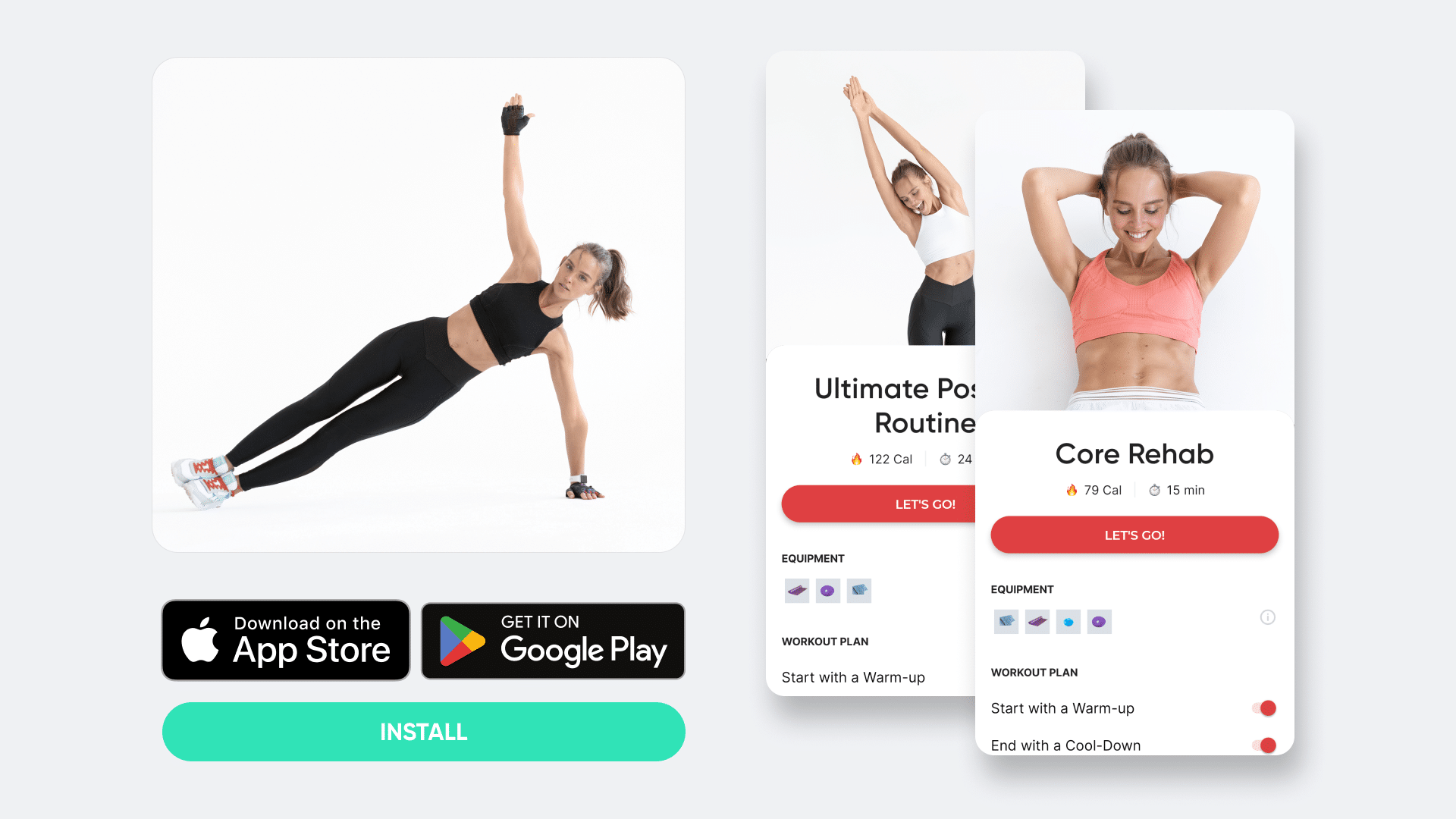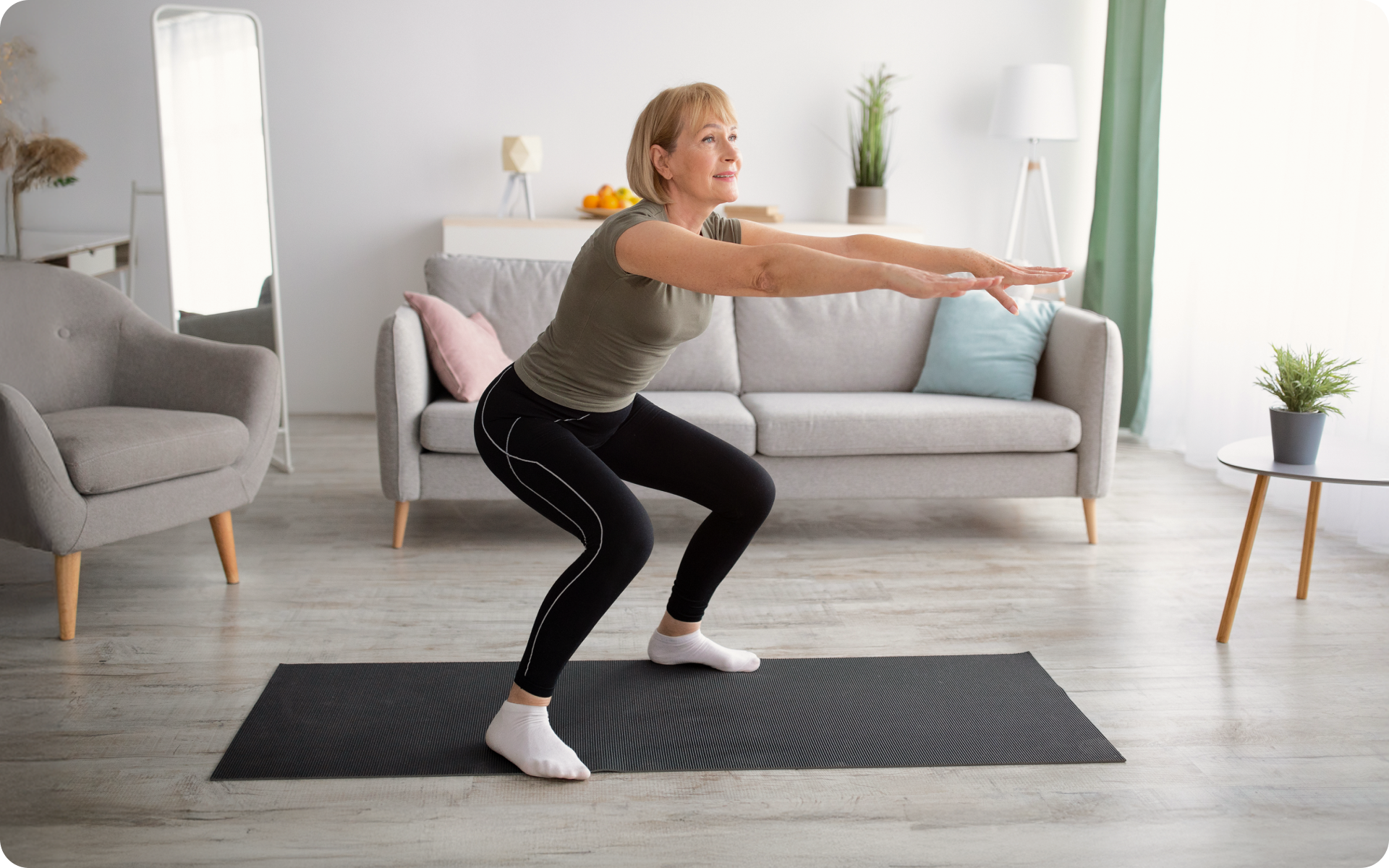Although the cardinal rule of fitness is consistency, many people are tempted to turn to quick fixes. These are rarely effective for lasting results. If improving your fitness without stretching yourself thin with tough workouts is your aim, then developing consistent habits is the way forward. Introducing the 90-day workout challenge — an optimal routine that ticks all the right boxes.
What is the logic behind a 90-day workout plan? The idea is that it takes an individual anything between 18 and 254 days to form a new habit and an average of 66 days for a new behavior to become automatic. With a 90-day routine, the notion of becoming consistent becomes a reality. (7)
The 90-day workout challenge is designed to make fitness part of your everyday life. You can ultimately improve your fitness and reduce body fat in three by following your plan diligently. Here’s what you need to know about the 90-day workout challenge and everything it entails.
Before we look at how to execute the 90-day workout challenge, let’s first look at the types and benefits of the routine and the kind of transformation it can lead to.
The 90-Day Workout Challenge Using Bodyweight Workouts
When it comes to fitness, many people associate it with going to the gym and using fancy, challenging equipment. However, more often than not, it’s difficult to keep the routine going as it requires effort and extra time to travel to the gym.
With bodyweight workouts, you can say goodbye to the age-old system of a gym and weights. These are exercises that leverage your own weight to create resistance against gravity. They are also called calisthenic strength training exercises.
Why are bodyweight workouts recommended?
Bodyweight exercises offer a versatile and accessible approach to strength training while catering to a broad spectrum of people who are seeking to improve their physical capabilities.
Bodyweight training revolves around fundamental movements that engage simple abilities, including:
- Pushing
- Pulling
- Squatting
- Bending
- Twisting
- Balancing
Several well-known exercises such as push-ups, pull-ups, and sit-ups fall within the realm of bodyweight training.
The adoption of bodyweight training has gained popularity in recent decades among both recreational enthusiasts and professional athletes, thereby highlighting its effectiveness and widespread acceptance.
The primary benefits of bodyweight workouts include:
- Enhancement of Biomotor Abilities: Bodyweight exercises contribute to the development of various biomotor abilities, which include strength, power, endurance, speed, flexibility, coordination, and balance. (3)
- Functional Strength Development: The movements involved in bodyweight workouts mimic real-life activities, which promotes the development of functional strength. This translates to improved performance in daily tasks and activities.
- Increased Flexibility and Mobility: These types of exercises involve dynamic movements that contribute to better flexibility and mobility, which can lead to better joint health and a reduced risk of stiffness. (9)
- Full-Body Engagement: By engaging multiple muscle groups at the same time, bodyweight exercises promote a more holistic approach to strength training. This degree of full-body movement contributes to a well-rounded and balanced physique.
Reasons why BetterMe is a safe bet: a wide range of calorie-blasting workouts, finger-licking recipes, 24/7 support, challenges that’ll keep you on your best game, and that just scratches the surface! Start using our app and watch the magic happen.
The secondary benefits of bodyweight workouts include:
- More Convenience and Accessibility: These workouts can be performed virtually anywhere and require minimal or no equipment. This accessibility allows individuals with varying levels of resources and time constraints to engage in self-improvement.
- Cost-Effective: As it involves minimal or no equipment, bodyweight workouts are the most cost-effective alternative to gym memberships or buying specialized workout gear, which makes it an attractive option if you’re on a budget.
- Adaptable to Any Fitness Level: With bodyweight workouts, it doesn’t matter whether you’re a beginner or an experienced fitness enthusiast. The routine can be tailored to suit your current fitness level and progression is achievable by increasing repetitions, adjusting exercise difficulty, or incorporating variations.
- Time Efficiency: These workouts, particularly options such as high-intensity interval training (HIIT), often require less time than traditional gym sessions and provide an efficient and effective way to achieve fitness goals.
For a 90-day workout plan, it is often recommended not to burden yourself with added layers such as physically going to the gym or buying gear. For a smoother transition, it is advisable to choose bodyweight workouts such as yoga, pilates, and HIIT.
Another challenge you could consider is the 28-day indoor walking weight loss challenge, which provides similar benefits such as cost-effectiveness, accessibility, and time efficiency.
How Effective Is 90-Day Body Transformation?
The most important principles of the 90-day workout challenge are creating a routine and maintaining consistency throughout the challenge. If you exercise consistently for 90 days, you’ll certainly see improvements in body composition and overall fitness level.
Let’s take a closer look at why consistency plays such an important role in body transformation:
- Adaptive Body Response: Consistency is the catalyst for positive physiological adaptations to the routine. Regular, sustained effort allows the body to progressively respond to the demands of the workout, which results in improved strength, endurance, and overall fitness. (12)
- Habit Formation: As previously mentioned, a consistent workout routine establishes positive habits. The daily commitment creates a rhythm that reinforces the importance of prioritizing health and fitness, thereby laying the groundwork for long-term well-being. A 90-day challenge won’t just make you lose weight, it will allow you to go on a journey of habit formation.
- Mental and Emotional Resilience: Consistency fosters discipline and resilience. When you complete the challenge day after day, this builds a mindset that is more likely to overcome obstacles and stay committed to the long-term goal.
- Motivation Through Incremental Progress: With regular, consistent effort, you can achieve incremental progress. Seeing tangible improvements in performance and physique provides sustained motivation, and reinforces the belief that goals are achievable.
However, another key factor that needs to be considered is your meal plan. Ensuring there is a caloric deficit while also performing the exercises consistently is the key to weight loss. (10, 5)
Read more: The 28-Day Indoor Walking Weight Loss Challenge Explained
Can I transform my body in 90 days?
The simple answer to this question is yes. However, a few strategies need to be kept in mind while doing so:
- Consistent, structured workouts are the basis of this transformation. Whichever type of workout you gravitate toward, the fact remains that exercise is essential for getting in shape. With structure, you can work more realistically toward your goals.
- The other aspect of this transformation is healthy eating. Improved diets, healthier ingredients, and abstinence from harmful foods such as refined carbs and alcohol are also important when you’re trying to achieve a full-body transformation. A focus on lean proteins, complex carbohydrates, and healthy fats provides a nutritionally sound diet that helps with weight loss.
- Adequate sleep and proper hydration are also crucial aspects of fitness. Water is essential for a variety of bodily functions, including metabolism and recovery, while quality sleep is vital for muscle repair, hormone regulation, and mental focus. (6, 1)
- While you’re on your fitness journey, another thing to remember is to regularly monitor your progress through measurements, photos, or fitness assessments. This provides positive reinforcement and helps you keep a systematic log of your progress.
- The cultivation of a positive mindset and remaining motivated throughout the process form the psychological aspects of this journey. Mental resilience is as important as physical effort. Being patient goes a long way, in addition to identifying that true transformation requires effort, rather than being dejected at minor setbacks.
How To Start A 90-Day Challenge?
While it is easy to visualize yourself on your fitness journey, the most difficult step you’ll take is often the first one. This is why a challenge such as the 90-day workout challenge is a great starting point as it provides you with a roadmap of how to get there.
Below, we have outlined the steps you can follow to start the 90-day workout challenge:
- Setting Clear Goals: Whether it’s weight loss, muscle gain, or improved fitness, the first step of the process involves setting clear goals that aren’t too unrealistic or far-fetched.
- Drafting A Structured Plan: To better organize yourself, develop a detailed plan that incorporates workouts, nutrition, and rest that aligns with your goals.
- Setting Realistic Milestones: To sustain your motivation, break down your goals into smaller, achievable milestones for each phase of the challenge.
- Tracking Progress: Implement a system to monitor and track your progress, and adjust the plan as and when required.
- Staying Accountable: To ensure you’re not slacking, share your progress with friends or join a community for support.
- Prioritizing Recovery: The most important aspect is giving your body enough downtime. Allow adequate time for rest and recovery to prevent burnout and support overall well-being.
What Is the Best 90-Day Workout Plan to Lose Weight?
One of the 90-day workout plans we suggest is the Wall Pilates Challenge. Wall Pilates is recommended for its versatility, effectiveness, and adaptability, and it provides a challenging yet rewarding workout experience with several health benefits.
Let’s take a closer look at the benefits of Wall Pilates before we proceed to a sample 90-day workout challenge plan:
- Versatility and Adaptability: Wall Pilates utilizes the one piece of equipment that’s easiest to find: a wall. The wall is used for support and resistance, offering a versatile workout that is adaptable to different fitness levels.
- Increased Resistance and Intensity: This type of Pilates adds resistance, which intensifies exercises for greater strength gains and calorie burn compared to traditional Pilates.
- Improved Alignment and Posture: With Wall Pilates, the importance is on proper form, minimizing injury risk, and enhancing overall posture and body awareness.
- Greater Balance and Stability: This stay-at-home workout focuses on stability during exercises, which makes balance improvement accessible and promotes core engagement.
- Diverse Workout Elements: This type of bodyweight workout incorporates elements from mat Pilates, reformer Pilates, and yoga, offering a varied and engaging workout experience that you’ll seldom become bored with.
- Accessibility: The ease with which Wall Pilates can be practiced anywhere with a wall and a mat is its best quality, as it makes working out accessible for individuals without expensive equipment.
- Calorie Burn and Weight Loss: This workout intensifies utilizing resistance for higher calorie burn, which contributes to increased muscle mass and supports weight loss efforts.
- Additional Health Benefits: Other benefits include alleviating pain, enhancing cognitive function, improving athletic performance, supporting bone health, boosting mood, and reducing stress. (11)
Whether you’re undertaking the Wall Pilates 21-Day Challenge or going the full mile with the 90-day workout challenge, this routine will provide a holistic, long-term solution to getting fitter.
BetterMe app will provide you with a host of fat-frying fitness routines that’ll scare the extra pounds away and turn your body into a masterpiece! Get your life moving in the right direction with BetterMe!
Sample 90-Day Challenge Workout Plan
Let’s now take a look at a 90-day workout plan that utilizes Wall Pilates as a routine for strength training. We’ve outlined the exercises for 4 weeks, which you can follow consistently for the 90-day duration. (8, 2)
However, increasing reps and intensity is advised as you move through the challenge duration.
WEEK 1:
2 Sets of 10 each
| Monday | Tuesday | Wednesday | Thursday | Friday | Saturday | Sunday |
|---|---|---|---|---|---|---|
| Supported Roll Down | Double Knee Bends | Unilateral Wall Slides | Supported Spine Twist | Supported Roll Down | REST | REST |
| Side Leg Swings | Wall Push-Ups | Active Calf Stretch | Wall Push-Ups | Side Leg Swings | ||
| Wall Crunch | Scissors | Opposite Toe Reach | Opposite Toe Reach | Wall Crunches |
WEEK 2:
3 Sets of 10 each
| Monday | Tuesday | Wednesday | Thursday | Friday | Saturday | Sunday |
|---|---|---|---|---|---|---|
| Side Leg Swing | Active Calf Stretch | Unilateral Wall Slides | Wall Side Plank | Wall Squats | REST | REST |
| Wall Crunch | Opposite Toe Reach | Single Leg Stretches | Wall Leg Presses | Side Leg Swing | ||
| Wall Sit | Wall Angel | Seated Toe to Chest | Opposite Toe Reach | Wall Bridge |
WEEK 3:
3 sets of 10 each
| Monday | Tuesday | Wednesday | Thursday | Friday | Saturday | Sunday |
|---|---|---|---|---|---|---|
| Lying Walks | Active Calf Stretch | Supported Spine Twists | Wall Planks | Active Calf Stretch | Wall Single-Leg Stretch | REST |
| Unilateral Wall Slides | Opposite Toe Reach | Wall Push-Ups | Seated Toe to Chest | Wall Hamstring Stretch | Wall Leg Slides | |
| Single Leg Stretches | Wall Angels | Opposite Toe Reach | Side Leg Swing | Unilateral Wall Slides |
WEEK 4:
4 sets of 10 each
| Monday | Tuesday | Wednesday | Thursday | Friday | Saturday | Sunday |
|---|---|---|---|---|---|---|
| Active Calf Stretch | Supported Spine Twists | Lying Walks | Seated Toe to Chest | Wall Push-Ups | Wall Bridge | REST |
| Opposite Toe Reach | Wall Push-Ups | Unilateral Wall Slides | Wall Leg Slides | Double Knee Bends | Wall Planks | |
| Wall Angels | Wall Sits | Single Leg Stretches | Scissors | Opposite Toe Reach | Wall Hamstring Stretch |
In addition to the 90-day workout challenge, you can take a look at our hydration challenge, which is a great way of kickstarting your wellness journey.
Read more: 6 Best Exercises for Skiing: Prepare Yourself for the Winter Fitness Challenge
FAQs
Does the 90-day workout challenge work?
Yes, a 90-day workout challenge can definitely show results such as improved fitness, strength, and overall health. The success of such challenges hinges on consistency, a well-designed exercise routine, and a balanced diet. The 90-day window allows for sustainable progress and the establishment of habits.
However, individual results are dependent on factors such as starting fitness levels, commitment, and adherence to the plan. To achieve lasting impact, it’s essential to view the challenge as a catalyst for long-term lifestyle changes, rather than a quick fix.
Can I get a perfect body in 3 months?
While the concept of a “perfect” body is subjective, varies widely, and is often debated, significant transformations are still achievable in three months with dedication. Progress is dependent on various factors such as starting fitness levels, genetics, the specificity of goals, and the consistency practiced.
Focusing on realistic objectives such as improved muscle tone, increased fitness, and healthy weight loss increases the likelihood of tangible results. It’s important to adopt a balanced approach that combines regular exercise, a nutritious diet, and sustainable habits for long-term well-being.
How much weight can you realistically lose in 90 days?
Realistic weight loss in 90 days is dependent on various factors, such as individual metabolism, starting weight, and lifestyle. A safe and sustainable goal is generally 1-2 pounds (0.5-1 kg) per week. Over 90 days, this could translate to a loss of approximately 12-24 pounds (5-11 kg). (4)
Rapid weight loss is often associated with muscle loss and may not be sustainable. Therefore, quick-fix diets are not recommended to achieve this weight loss. Emphasizing a balanced diet, regular exercise, and gradual, steady progress is the key to achieving and maintaining a healthy weight.
Is it possible to lose 15 kg in 90 days?
Losing 15 kg in 90 days is an ultra-ambitious and potentially unhealthy goal. Rapid weight loss of this magnitude is likely to involve extreme measures, which can risk muscle loss and cause the risk of nutritional deficiencies.
Sustainable and safe weight loss is generally recommended at a rate of 1-2 pounds (0.5-1 kg) per week. Aiming for a more realistic goal over 90 days, such as 5-10 kg, promotes healthier habits, reduces the risk of negative health effects, and increases the likelihood of long-term success. It’s essential to prioritize overall well-being over rapid, unsustainable weight loss.
The Bottom Line
When it comes to getting started on your fitness journey, it is always recommended to incorporate a sustainable, long-term approach rather than going for a quick fix. However, as starting is the most difficult step, you can swap conventional methods with a 90-day workout challenge.
Such a weight loss challenge provides a structured roadmap to workout routines and meal plans and also helps create a habit — habits that inevitably form the blueprint for the lifelong prioritization of health and fitness. To kickstart your journey, bodyweight training, particularly no-cost, ultra-effective routines such as Wall Pilates, is an excellent starter pack.
DISCLAIMER:
This article is intended for general informational purposes only and does not serve to address individual circumstances. It is not a substitute for professional advice or help and should not be relied on for making any kind of decision-making. Any action taken as a direct or indirect result of the information in this article is entirely at your own risk and is your sole responsibility.
BetterMe, its content staff, and its medical advisors accept no responsibility for inaccuracies, errors, misstatements, inconsistencies, or omissions and specifically disclaim any liability, loss or risk, personal, professional or otherwise, which may be incurred as a consequence, directly or indirectly, of the use and/or application of any content.
You should always seek the advice of your physician or other qualified health provider with any questions you may have regarding a medical condition or your specific situation. Never disregard professional medical advice or delay seeking it because of BetterMe content. If you suspect or think you may have a medical emergency, call your doctor.
SOURCES:
- 10 Reasons to Get More Sleep (2023, healthline.com)
- 30-Minute Wall Pilates Workout Plan For Beginners ( Oct 2023, betterme.world)
- Bodyweight exercise (wikipedia.com)
- Can you Lose 10 Pounds in a Month? (2023, healthline.com)
- Does Exercise Help You Lose Weight? The Surprising Truth (2023, healthline.com)
- Hydration to Maximize Performance and Recovery (2021, ncbi.nlm.nih.gov)
- How Long Does It Take for a New Behavior to Become Automatic? (2019, healthline.com)
- Pilates Wall Workout Chart: A Quick Guide For Beginners ( Oct 2023, betterme.world)
- The advantages of body-weight exercise (2022, health.harvard.edu)
- What Is a Calorie Deficit, and How Much of One Is Healthy? (2019, healthline.com)
- Why Is Wall Pilates So Effective? ( Oct 2023, betterme.world)
- (4) Workout Consistency Is The Most Important Factor For Muscle Growth (womenshealth.com.au)















